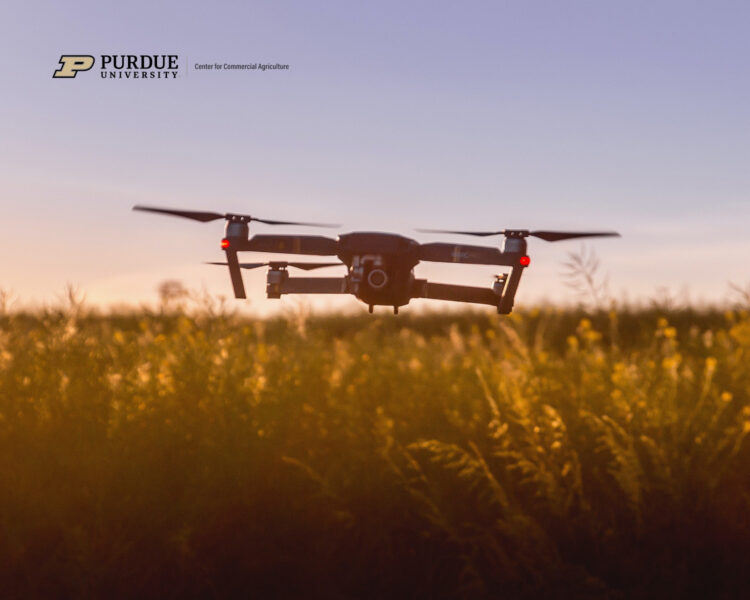March 5, 2021
Importance of New Technologies for Crop Farming
by: Michael Langemeier and Michael Boehlje
Adoption of technology has been important to production agriculture for decades. Through the adoption
of technology and improved managerial practices, aggregate agricultural U.S. farm output in the United
States tripled from 1948 to 2017 with almost no corresponding increase in aggregate input (USDA-ERS,
2021). For reasons explained below, the adoption of technology in production agriculture is expected to
accelerate in the next decade. This article discusses types of technology that are currently being adopted
or that are likely to be adopted in the near future. Upcoming articles will discuss the critical role of
information and precision agriculture technologies, possible payoffs of precision agriculture, automation
and robotics, and gaps in skills pertaining to the adoption of new technologies.
Changes to Crop Agriculture
Crop farming around the world is undergoing a profound technological transition. The management of
production is moving toward increased micro-management of production activities by individual field or
location within a field driven by site-specific information about environmental, biological, and economic
factors that affect physical output, profitability, and soil and water quality.
Increased use of monitoring technology will greatly expand the amount of information available regarding
what affects plant growth and well-being. This will be made possible by innovations in sensors to use in
monitoring and control systems, communication technologies, and data analytics. In addition, greater
understanding of how various growth and environmental factors interact is forthcoming. This
understanding will then be incorporated into management systems to determine optimum combinations of
inputs at the field or within a field level. Precision farming in crop production includes the use of global
positioning systems (GPS), yield monitors, and variable rate application technology to more precisely
apply crop inputs to enhance growth, lower cost, and reduce environmental degradation.
Growing crops through precision production practices might be described as “biological manufacturing”
which combines biotechnology and nutritional technology; monitoring, measuring, and information
technology; and process control technology. The critical linchpin among these “technologies buckets” for
successful execution is the data and information that can be continuously captured and utilized to
manage the system and intervene in real time to control and enhance the plant growth process.
The transition of production agriculture from an industry that grows crops to one that biologically
manufactures raw materials with specific attributes and characteristics for food and industrial use
products is well underway. The discussion below will focus on three types of technology: biotechnology
and nutritional technology; monitoring, measuring, and information technology; and process control
technology.
Biotechnology and Nutritional Technology
The focus of biotechnology and nutritional technology is to manipulate the growth, attribute development,
and deterioration process in plant production. An improved scientific base impacts not only plant growth
but attribute development and is providing additional capacity to manipulate and control processes. Also,
biotechnology is advancing our capacity to control and manipulate plant growth and development
including attribute composition (for example, starch or amino acid composition) through genetic
manipulation. By combining nutritional and biotechnology concepts with mechanical and other
technologies to control or adjust the growth environment (temperature, humidity and moisture, pest and
disease infestation, etc.), the process control approach and thinking that is part of the assembly line used
in mechanical manufacturing becomes closer to reality in biological manufacturing.
Monitoring, Measuring, and Information Technology
The focus of this technology is to trace the development and/or deterioration of attributes in the plant
growth process, and to measure the impact of controllable and uncontrollable variables that are impacting
that growth process. In crop production, yield monitors, global positioning systems (GPS), global
information systems (GIS), satellite or aerial photography and imagery, weather monitoring and
measuring systems, and plant and soil sensing systems are part of this technology. In future years, inplant sensors to detect growth rates and disease characteristics may be available. These systems will be
tied to growth models to detect ways to improve plant growth performance, as well as to financial and
physical performance accounting systems to monitor overall performance. The computer technology to
manipulate the massive amounts of information is readily available; new monitoring and measuring
technology including near-infrared (NIR) and electromagnetic scanning is now being developed to
measure a broad spectrum of characteristics of the plant growth process.
Process Control Technology
The concept of process control technology is to intervene with the proper adjustments or controls that will
close the gap any time actual performance of a process deviates from potential performance.
Greenhouse production increasingly utilizes such technology to manipulate sunlight, humidity,
temperature, and other characteristics of the plant growth environment. Irrigation systems are an
example of this technology in field crop production; modern irrigation systems tied to weather stations and
plant and soil sensors automatically turn irrigation systems on and off to ensure that moisture levels are
adequate for optimum growth. Variable rate application of fertilizer and chemicals and row shut-off
technology are current examples of process control technology in rain-fed crop production. Modern
precision planter technology that automatically adjusts seed placement, depth, and soil coverage based
on soil sensors is another example.
Combining real time monitoring and measuring technology with anytime intervention process control
technology has the potential to generate significant benefits. Any-time intervention technology allows one
to detect a problem when it occurs and in real-time solve that problem rather than anticipate a possible
problem and preemptively dispense control inputs that may be completely unnecessary (and thus costly)
and possibly even harmful to the growth environment if that problem does not occur. For example, anytime intervention technology allows the detection of corn borers and the treatment of those borers once
they meet an economic threshold, rather than spending funds and using materials in anticipation that a
corn borer infestation might occur which are unneeded if the infestation does not reach an economic
threshold during the growing season. A similar approach might be used to control weeds. Similar
approaches to fertility management may facilitate lower levels of pre-season fertilizer applications by
enabling additional applications during the growth season as real-time sensing technology and drop-down
nozzle attachments for high clearance equipment enable split applications of fertilizer to be applied when
needed. If such technology is developed, it may be less essential to use biotechnology to control certain
insects or larger than necessary fertilizer applications to insure the optimum yield.
It would be unrealistic to expect these process control and sensing technologies and methods to be as
successful as they have been in industrial manufacturing in reducing variability and systemizing the
processes of producing manufactured goods such as automobiles, computers, or even chemical and
industrial goods. However, it is also unrealistic to ignore the potential of these technologies in reducing
variability and obtaining more control over biological growth processes so as to increase efficiency,
reduce costs, improve quality, minimize environmental impacts and in general more systematically
produce biological based attributes for food, feed, fuel, and fiber raw materials. In essence, this is what
the concepts of biological manufacturing are all about, to use monitoring and measuring, biological and
nutritional manipulation, and process control technologies to systematically manufacture food and
industrial use products.
Concluding Comments
This article discusses types of technology that are currently being adopted or that are likely to be adopted
in the near future. Specifically, technologies related to biotechnology and nutrition; technologies related
to monitoring, measuring, and information; and technologies related to process control were briefly
described. It is not an understatement to note that these technologies are going to result in profound
changes to production agriculture operations. Upcoming articles will discuss the critical role of
information technologies, possible payoffs of precision agriculture, automation and robotics, and gaps in
skills pertaining to the adoption of new technologies in production agriculture.
______________________________________________________________
References
Erickson, B. and J. Lowenberg-DeBoer. “2020 Precision Agriculture Dealership Survey.” Departments of
Agricultural Economics and Agronomy, Purdue University, August 2020.
Pope, M. and S. Sonka. “Evidence, Data and Farmer Decision Making.” farmdoc daily (10):45,
Department of Agricultural and Consumer Economics, University of Illinois at Urbana-Champaign, March 11, 2020.
Thompson, N.M., C. Bir, D.A. Widmar, and J.R. Mintert. “Farmer Perceptions of Precision Agriculture
Technology Benefits.” Journal of Agricultural and Applied Economics. 51(Issue 1, 2019):142-163.
United States Department of Agriculture, Economic Research Service. Statistics Service. Agricultural
Productivity in the U.S., https://www.ers.usda.gov/data-products/agricultural-productivity-in-the-us/,
accessed on February 26, 2021.
TEAM LINKS:
PART OF A SERIES:
RELATED RESOURCES
Margaret Lippsmeyer presented during agri benchmark’s 2024 annual conference in mid June, which was hosted by the Spanish Ministry of Agriculture in Valladolid, Spain. An increase in soybean acreage may come from either (a) shifting away from continuous corn rotations to corn-soy and (b) shifting corn-soy rotations toward corn-soy-soy. Based on agri benchmark data, Margaret showed that option (a) would require an increase in soybean prices of 6% and option (b) of 8% to make these rotations preferable over existing ones.
READ MOREUPCOMING EVENTS
We are taking a short break, but please plan to join us at one of our future programs that is a little farther in the future.






